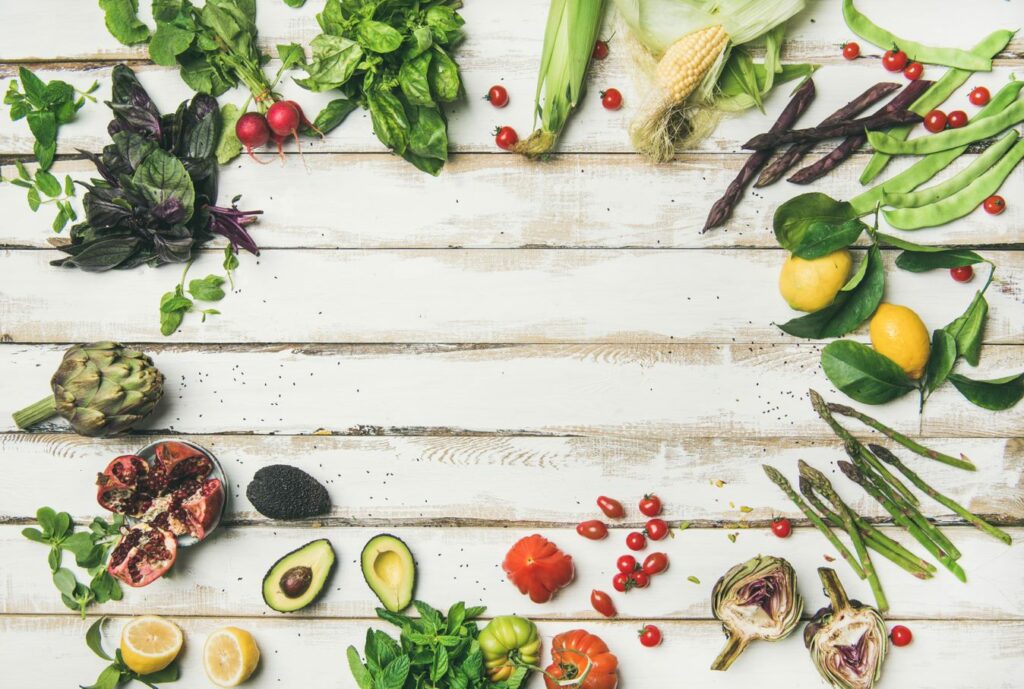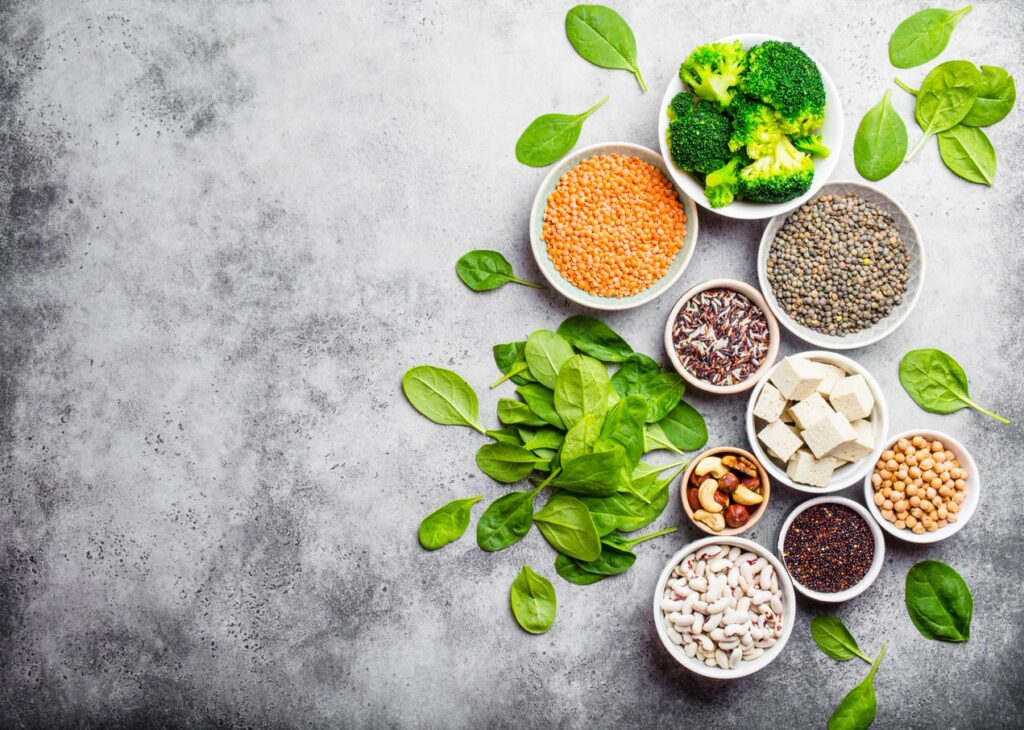Contents:
Nutrition basics
Budget Tips
Base shops
Example menu
Recipes
Lelita Baldock is a web-developer by day, fiction author by night. Part-time nutritionist, full-time foodie. She says: “I love food. But I am also very busy. So for me, healthy, satisfying meals that are quick and easy to prepare, that also come in on a tight budget are essential” Follow her tips & recipes here
It’s the new year, a time of renewal, resolutions and looking forward to the future. And if you are anything like me, a time to focus on healthy choices. The festive season is delightful, but it can often come with over-indulgence. And that’s all part of the fun. But by January our bodies can be crying out for simpler, more nourishing meals.
Luckily for us in the UK, January is also a time of hearty, healthy seasonal produce: think root vegetables and leafy greens. Perfect food to nourish our bodies and come in on a budget too.
The cost of living has been rising, and many of us are feeling the pinch. So it is natural that we are looking for savings everywhere, including on our grocery bill.
But budget doesn’t mean meals can’t be delicious too!
To help us all incorporate healthy, nourishing meals into our routine, while also being budget conscious, I have put together a series of tips and recipes to guide your choices. And have fun with food!
Nutrition basics
Let’s start with the basics of nutrition. We all know we want to be eating a minimum of 5 servings of fruit and vegetables a day. This baseline ensures our intake of fibre, vitamins and minerals. Also fruits and vegetables are some of the most nutrient dense foods on the planet. Low in calories, high in nutrition. The perfect bang for your buck!
So, the first focus is to increase your intake of fruits and vegetables.
Add berries or chopped fruit to breakfast cereals or toast.
Add spinach or kale to smoothies.
Include vegetables with lunch and dinner.
And my biggest tip? Include a serve of beans/pulses everyday. Beans are a nutrition powerhouse. Packed with fibre and plant-based protein, they are filling and great for digestion. Including them is easy. Spread hummus on wraps or sandwiches, add lentils to soups and stews, mix white beans into salads.

Aim for 30 different plants a week. Time and time again, research is showing the importance of fibre and consuming a variety or different plants. The fibre and variety supports the development of a healthy microbiome. Don’t get hung up though, 30 is just a positive goal.
Other tips to round out your nutrition basics are:
Enjoy dairy twice a day. Top porridge with yogurt, snack on a slice of cheese, add milk to coffee and tea. If you are plant-based or doing veganuary, swap your animal products for plant alternatives, just be sure to choose calcium fortified options (see more veganuary tips below).
Base each meal on whole grains or starches. Grains and starches are rich sources of soluble fibre, that type of fibre that adds bulk to our stool and helps waste move smoothly through our digestive tract. Full of nutrition and filling, these foods should form the base of each meal.
Snack on fruit, dairy or nuts. An easy way to reach your five a day.
Keep red meat to a maximum of two serves per week. Red meat is a great source of iron and protein, but we don’t need huge quantities. Enjoy up to twice a week.
Enjoy fish. Fish is a lean, healthy protein that also boosts our intake of healthy omega 3 fats. Aim for two serves per week.
So how do we keep to a budget?
With the rising cost of living many of us are looking to save where we can. And our food budget is a great place to look for bargains.
Healthy eating does not have to be expensive. Here are some tips to fill your plate with nourishing food at a low price.
Budget Tips:
Buy in season
Use what you have: stew, soup, roast veggies – don’t let anything go to waste, it can all be made into a meal
Use fresh first so thing’s don’t go off
Add bulk: cabbage, kale, spinach will add nutrition and satiety to meals for low cost
Halve meat and add beans/ pulses to make it go further
Cook in bulk
Buy in bulk. Purchase large bags of staples like rice/pasta/potatoes. If you have time to prep them, choose dried beans/ pulses and soak, rinse and cook. With meat/poultry/fish buy large amounts when on special and portion and freeze
Focus on starches. Cheap and filling
Use herbs and spices for flavour, rather than buying packaged food
Buy the fruit that is on sale. If apples are 6 for £1, buy apples, if oranges are on special, buy oranges
Purchase essentials then add extras according to budget: fresh herbs, out of season veg (eg salad items for sandwiches/ wraps)
So what’s in season in January?
Think hearty roots and filling greens:
Potato
Swede
Parsnip
Carrot
Beetroot (can cook and eat leaves too!)
Cabbage
Kale
Onion
Leek
Another budget tip is to include frozen fruits and vegetables. Frozen is great. Produce is snap-frozen as soon as possible after picking, which ensures that the nutrients are kept. You can buy frozen food at a lower cost and in bulk to save money. Great for fruit and meal bulking veggies.
Putting it all together
As an example, I have created a 2 week meal plan that will provide all your nutritional needs, with all meals coming in at under 30p per serve (most even less).
This menu is what I call a ‘base shop’. It is a plant-based menu that will cover all your nutritional needs, for around 30 pounds.
Base shop
Potatoes x6
Carrots x4
Parsnip
Swede
Pumpkin
Cabbage
Onion
Leek x2
Avocado (if you enjoy them, buy the large bags much better value)
Apples x3
Pears x3
Frozen mixed berries
Frozen peas
Frozen ratatouille mix
Frozen spinach
Peanut butter
Bread mix
Canned tomatoes x2
Canned chickpeas x2
Canned cannellini beans x2
Canned red kidney
Canned lentils
Basmati rice
Porridge oats
Pasta
Almond milk (traditional milk is fine, this is just personal preference)
You can take this base menu and then add meat and dairy as per your taste, preference and budget. To keep the cost of these additional lower, go for bulk:
Dairy
Buy litre tubs of yogurt for breakfast topping and snacks
Choose large cheese blocks for sandwiches and grated on meals
Meat/ fish/ poultry
Halve your meat portion and mix with beans/pulses to make it go further
Look for bargains, choose cheaper options such as: beef chunk, chicken drumsticks, fish pie mix
Example fortnight menu
All meals are quick and easy to make, simply peal, wash and chop the produce, put it in a pot, cover with water and cook. All can be cooked in a slow cooker or on a stove top. You can sauté or fry the onion first if desired. But I am a lazy cook, so I just put it all into a pot and cook!
All herbs are optional. Fresh or dried is fine. Add according to preference and availability
Breakfasts:
Oats, berries, linseed
Toast peanut butter apple slices
Lunches:
Leftovers
Sandwich topped with bean spread and lettuce/ grated carrot/ spinach/ tomato/ cucumber
Soup – I have chosen pumpkin, leek and white bean soup
Dinners:
Pumpkin, pea, spinach, thyme risotto
White bean, carrot, onion (sage optional) stew over baked spud
Slow-cooker root stew (beef optional)
Ratatouille and lentil pasta
Shepards pie with lentils carrots, peas, onion (mince optional)
Cabbage and red lentil dahl over rice (fish optional)
Chickpea, spinach, tomato stew over rice or pasta (chicken optional)
Other budget meal ideas:
Muesli and milk/ yogurt
Corn and potato chowder with peppers
Goan fish curry
Fish pie
Beef stew
Pea and ham soup
Tuna and corn in baked spud
Baked beans on toast with cheese
Potato and spinach pie
Sardines on toast with spinach and tomato slices
Chicken drumsticks with rice and steamed veggies (great in air-fryer)
Red lentil, chickpea, can tomatoes, onion, pepper and chipotle
Red lentil, grated carrot, onion, gammon soup
Peas, onion, bacon soup
Salmon, pea, spinach risotto with fresh dill
Time-saving tips:
I like to bulk cook on the weekend, portion and freeze. Great time saver.
I will cook up the following on a Sunday to enjoy through the week:
Soup for lunches
Bean spread (e.g. hummus) for sandwiches/ wraps
Stew for dinner
Pasta sauce to top pasta or baked potatoes
Curry to top rice
A bake/ pie
Some Veganuary swaps for healthy plant-based eating
Veganuary is a fun way to focus on getting more plants on your plate, and do something for the environment and animals. If you are vegan, or looking to eat more plant-based, here are some tips to ensure you are still getting all the nutrition you need:
Plant-based swaps:
Beef – lentils
Chicken – chickpeas/ tofu
Fish – white beans
Milk – oat milk
Iron – eat plant foods rich in iron with foods high in vitamin c, this helps iron absorption
Calcium – fortified plant milks such as almond, oat, soy
If you eat vegan long term, add in a high quality vitamin b12 supplement

Whole grain swaps
It is not essential to choose whole grain options. If you are getting a variety of fruits and veggies you will cover your fibre needs. But whole grains are more nutritious and higher in fibre than their more processed equivalents. Experiment and find some you like.
Bread – grainy/ whole grain bread
White rice – brown rice
Pasta – whole grain pasta/ bean based pasta
White wraps – corn tortillas
Herbs and spices
Herbs and spices add flavour and variety to your meals. The initial cost to purchase them can be high, but a little goes a long way. They will last you for many meals. My tip would be to stock up your spices over time, purchasing something new each week as you build up your selection.
The essentials I swear by for versatility and taste are:
Dried thyme
Paprika
Cumin
From just these three options alone you can create all manner of Mexican, Indian and European dishes.
Condiments
Mustard – a little goes a long way
Mayo – buy in bulk for dressings
Ketchup – if you like
Hot sauce – great for extra flavour and affordable
By focusing on eating a variety of in season fruits and vegetables, basing meals on grains and starches and adding small portions of meat/ fish/ poultry and dairy, you can build a tasty, health-promoting meal plan that is also affordable.
Experiment with different recipes, use what you have, and most of all, enjoy your food!
Recipes
Breakfast Oats
Serves 3-4
· 1 cup rolled oats
· 2 cups milk
· 2 cups mixed fruit of choice
· Yogurt for topping
Place oats and milk in saucepan. Heat until oats are soft.
Serve with a dollop of yogurt and portion of fruit.
Breakfast fruit toast
Serves 1
· 2 slices whole wheat toast
· 2 teaspoons peanut butter
· 1 banana
Toast bread.
Spread with peanut butter. Top with chopped banana
(Tip: experiment with different nut butters and fruit combinations. I love almond butter and blueberries)
Bean-spread open sandwich
Serves 2
· 4 slices whole grain bread
· 1 can white beans, drained and rinsed
· 1 avocado
· 1 cup salad vegetables of choice, eg chopped tomato, cucumber, lettuce, spinach
Place beans and avocado in a bowl. Mash together until mixed like a chunky spread
Toast bread. Top with bean spread and salad vegetables. enjoy.
Pumpkin and white bean soup
Serves 4-6
· 1 whole pumpkin (technically out of season, but always a cheap staple at the supermarket)
· 1 can cannellini beans – drained and well rinsed
· 1 leek – green part discarded. Washed and chopped
· 1 litre chicken stock or water and salt to taste
· Dried thyme
Chop pumpkin and leek. Add all ingredients into a saucepan. Cover with chicken stock.
Cook until pumpkin is soft. Allow to cool. Blend with stick blender. Sprinkle with dried thyme.
Serve warm with thick slice of whole grain toast.
Pumpkin, pea, spinach, thyme risotto
Serves 4-6
· 1 cup basmati rice
· 1 cup chopped pumpkin
· 4 rounds of frozen spinach (or 2 cups fresh)
· 1 brown onion, finely chopped
· 1 cup frozen green peas
· 2 cups chicken stock, or water and salt to taste
Place all ingredients in a saucepan. Cook over medium heat until rice is cooked and vegetables are soft. Serve warm. Optional – top with grated cheese
Slow-cooker root stew
Serves 6-8
· 1 swede
· 2 potatoes
· 2 carrots
· 2 celery stalks
· 1 brown onion
· 1 parsnip
· 200 grams chunk beef (optional)
· Chicken stock to cover
· Black pepper to taste
Peal and chop all vegetables into large chunks. Place in a saucepan with beef if using. Cover with stock and cook on medium to low heat until cooked.
Serve warm.
White bean, carrot, onion (sage optional) stew over baked spud
Serves 3-4
· 1 can white beans, drained and well-rinsed
· 2 carrots
· 2 stalks celery
· 1 brown onion
· 4 sage leaves, chopped finely
· 1 potato per person
Peal and chop carrot, celery and onion. Place in a saucepan with white beans. Add chopped sage. Cover with water. Cook on medium heat until all vegetables are soft.
While cooking, wrap potatoes in foil and bake in the oven until soft.
Serve potatoes cut open with bean mix as filling. Optional – sprinkle with grated cheese.
Ratatouille and lentil pasta
Serves 4-6
· 1 packet of mixed Mediterranean vegetable: eg. courgettes, aubergines, peppers, tomatoes
· 1 can lentils, drained and well rinsed
· Chicken stock
· Pasta for number of people you are feeding
Place vegetable mix and beans in a saucepan. Cover with chicken stock. Cook until soft and soupy.
Cook pasta according to package instructions.
Serve vegetable mix over pasta. Optional – add a sprinkle of grated cheese
Shepards pie with lentils carrots, peas, onion (mince optional)
Serves 6-8
· 1 can lentils, drained and well rinsed
· 1 cup frozen pea
· 2 carrots, pealed and chopped
· 1 can chopped tomatoes
· 4 rounds frozen spinach
· 250 grams lean beef mince (optional)
· 2 large potatoes
· 1/2 cup grated cheese (optional)
Place all ingredients except potato into a pot. Cover with water and cook until vegetables are just soft. Add salt and pepper to taste.
While cooking. Boil and then mash potatoes.
Pour vegetable and beef mix into a baking dish. Cover with mashed potatoes. Sprinkle with grated cheese (optional).
Bake in the oven at 180 degrees for around 20 minutes, or until top is golden brown.
Serve hot.
Cabbage and red lentil dahl over rice (fish optional)
Serves 3-4
· 1/2 green cabbage, washed and chopped
· 1 cup dried red lentils
· 1 carrot grated
· 250 grams fish pie mix
· 1 can diced tomatoes
· 1 cup water
· 2 teaspoons curry powder (or, if you have them, a teaspoon each of: turmeric, cumin, chilli flakes)
· Salt and pepper to taste
· Rice for each person
Place all ingredients in a saucepan and cook until lentils are soft.
Cook rice according to package instructions
Serve over a portion of rice
Top with fresh herbs like coriander (optional)
Chickpea, spinach, tomato stew over rice or pasta (chicken optional)
Serves 3-4
· 1 can chickpeas, drained and well rinsed
· 4 rounds frozen spinach
· 1 can diced tomatoes
· Salt and pepper to taste
· 250 grams chicken thighs, diced (optional)
Rice or pasta for number of people
Place all ingredients in a saucepan and cook until soft.
Cook rice or pasta according to package instructions
Serve vegetables over rice or pasta









